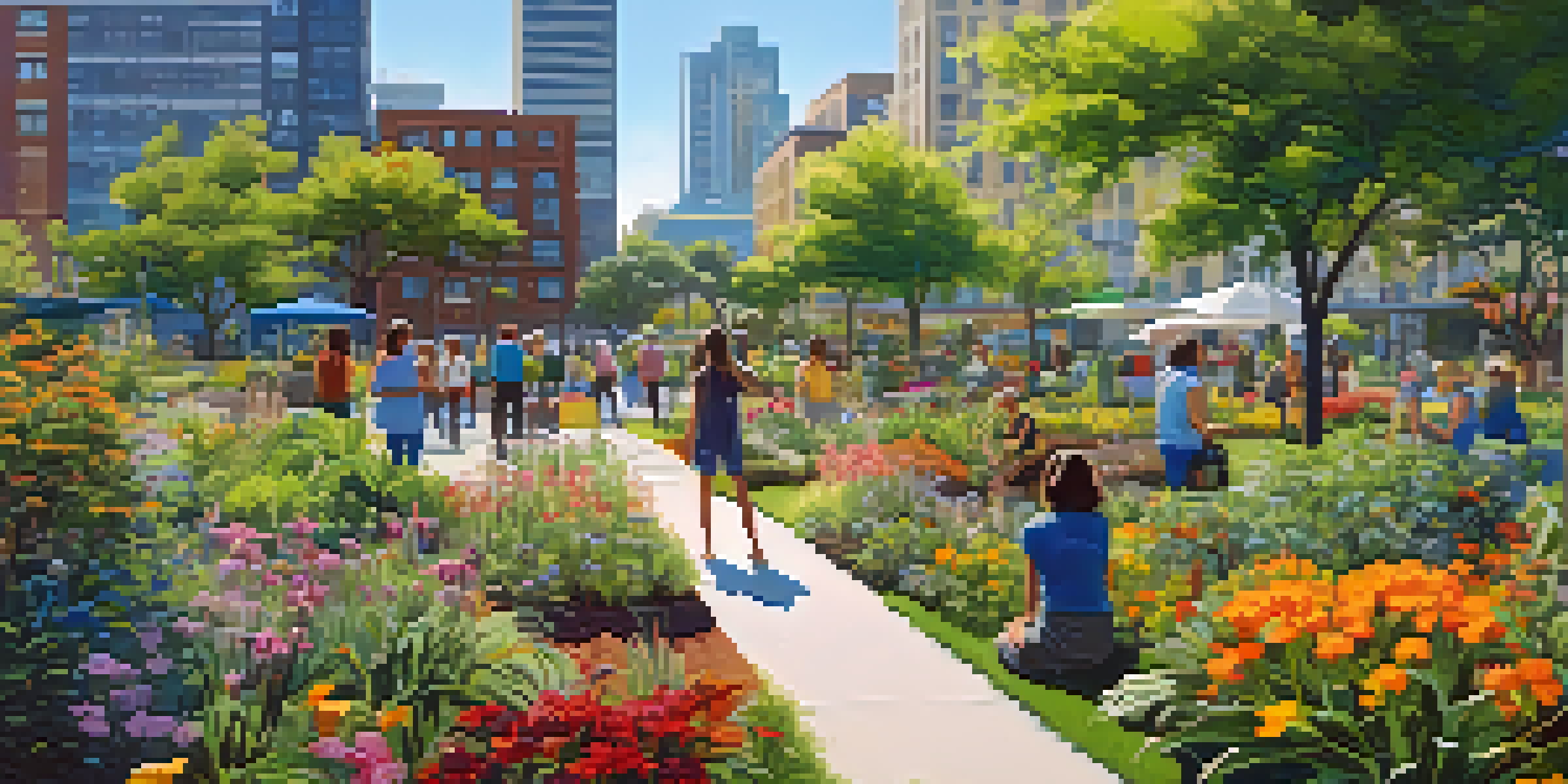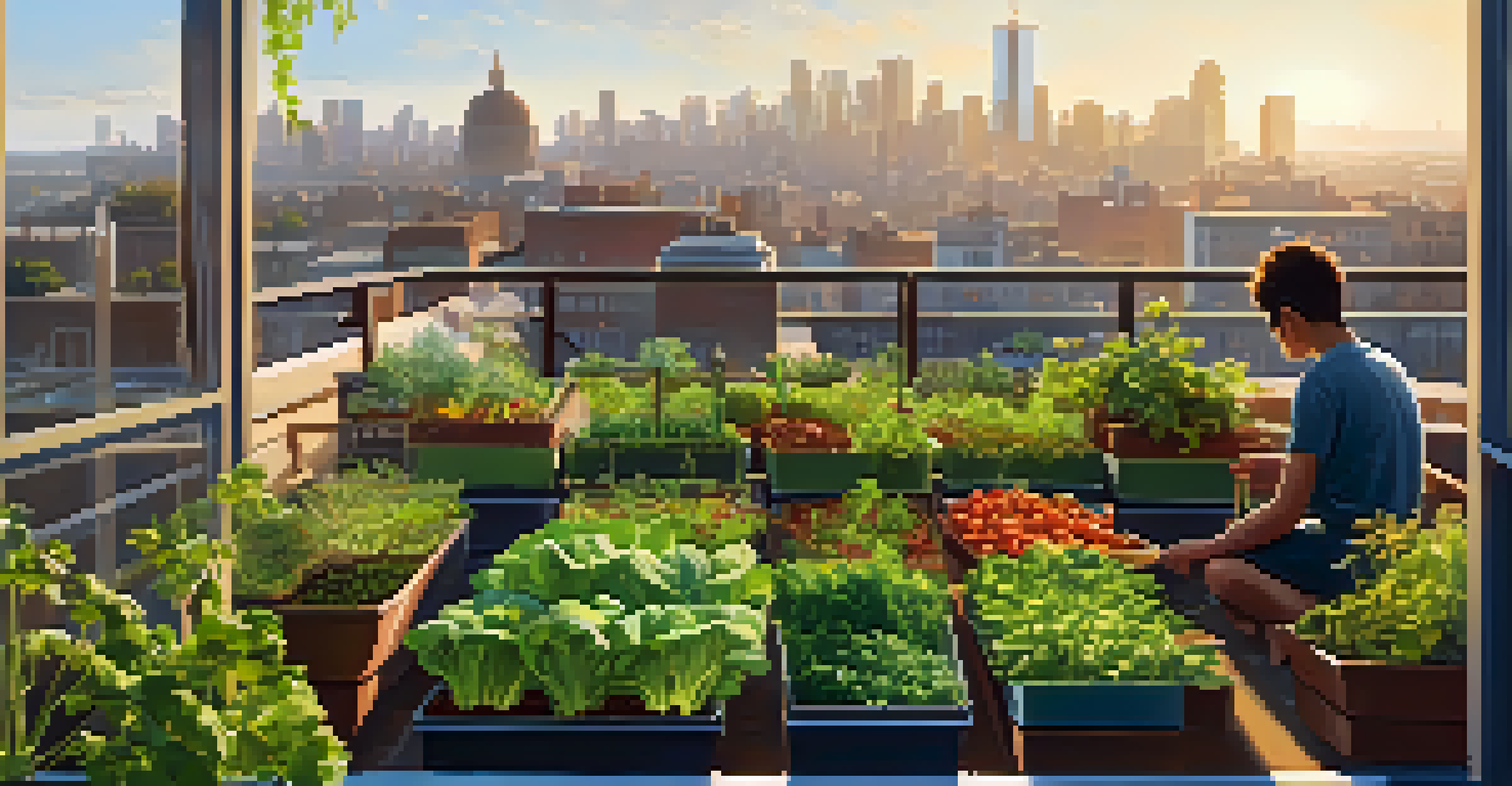The Importance of Urban Plants in Supporting Biodiversity

Urban Plants: A Crucial Component of Biodiversity
Urban plants play a vital role in supporting biodiversity, acting as green lungs in cities. They create habitats for various species, from birds to insects, fostering a rich ecosystem even in the heart of urban environments. By introducing diverse plant species, we can mimic natural ecosystems, making cities more resilient and ecologically balanced.
The greatest threat to our planet is the belief that someone else will save it.
Moreover, urban vegetation helps to bridge the gap between fragmented natural habitats. When different plant species coexist, they attract a variety of wildlife, which can thrive in urban settings. These interactions not only enhance biodiversity but also create a sense of belonging for residents who witness nature's resilience.
As cities expand, recognizing the importance of urban plants becomes essential. They are not just for beautification; they are critical assets that contribute to the overall health of our urban landscapes. By fostering biodiversity through plants, we can create a more sustainable and vibrant urban future.
How Urban Green Spaces Benefit Local Wildlife
Green spaces in urban areas serve as essential refuges for wildlife. Parks, gardens, and green roofs provide crucial habitats that support various species, allowing them to thrive amidst the concrete jungle. For example, a single community garden can provide food and shelter for numerous pollinators, which are vital for our food systems.

These urban green spaces also act as stepping stones, connecting different habitats and enabling wildlife to move safely between them. Such connectivity is crucial for species survival, especially in rapidly urbanizing areas. When plants flourish, so does the local fauna, creating a vibrant ecosystem.
Urban Plants Boost Biodiversity
Urban plants create habitats for various species, enhancing local ecosystems even in dense cities.
Additionally, urban green spaces promote ecological diversity, offering a range of microhabitats. The variety of plants can support different species, ensuring that local wildlife has the resources it needs to flourish. As cities incorporate more green areas, they become havens for biodiversity.
The Positive Impact of Urban Plants on Climate
Urban plants are not just pretty faces; they play a significant role in climate regulation. By absorbing carbon dioxide and releasing oxygen, they help mitigate the effects of climate change. Furthermore, vegetation cools urban heat islands, which can be a significant issue in densely populated areas, making cities more livable.
Nature does not hurry, yet everything is accomplished.
Trees and plants also reduce stormwater runoff by absorbing rainwater. This natural filtration system prevents flooding and reduces the burden on urban drainage systems. When cities invest in greenery, they are essentially investing in their resilience against climate-related challenges.
Moreover, urban plants improve air quality by trapping dust, pollutants, and particulate matter. This leads to cleaner air and a healthier environment for city dwellers. By supporting urban plants, we are creating not only beautiful spaces but also healthier communities.
Enhancing Human Well-Being Through Urban Greenery
The presence of plants in urban areas significantly enhances the quality of life for residents. Studies show that access to green spaces can reduce stress, improve mood, and promote overall mental health. Imagine taking a stroll through a lush park; the calming effect of nature can work wonders on our well-being.
Additionally, urban plants encourage physical activity by providing spaces for recreation and leisure. Whether it’s jogging in a park or gardening in a community plot, these activities foster a healthy lifestyle. Green spaces also promote social interactions, bringing people together and strengthening community bonds.
Green Spaces Aid Climate Resilience
Vegetation in urban areas helps mitigate climate change effects through carbon absorption and cooling.
Furthermore, exposure to nature can spark creativity and inspire innovation. Urban environments adorned with greenery can lead to a more engaged and productive populace. By prioritizing urban plants, cities can cultivate not only a healthier environment but also a happier, more connected community.
Urban Plants and Their Role in Food Production
Urban agriculture is on the rise, and plants are at the forefront of this movement. Community gardens and rooftop farms are transforming city spaces into productive landscapes, allowing residents to grow their own food. This not only promotes food security but also fosters a deeper connection between people and their environment.
Moreover, growing food in urban areas can reduce the carbon footprint associated with transporting produce. Local sourcing means fresher food with fewer emissions. The integration of plants into urban settings can lead to more sustainable food systems, empowering communities to take charge of their nutrition.
In addition, urban gardens provide educational opportunities for residents, especially children, to learn about agriculture and the importance of biodiversity. These hands-on experiences cultivate an appreciation for nature and sustainable practices, ensuring that future generations value urban plants and their contributions.
The Importance of Native Plants in Urban Environments
Native plants are particularly important in urban settings as they are adapted to local conditions and provide essential resources for local wildlife. By planting species that are endemic to the area, we can support the natural ecosystem and enhance biodiversity. Native plants often require fewer resources, making them a sustainable choice for urban landscaping.
These plants also play a crucial role in maintaining soil health and preventing erosion. By establishing deep root systems, they help stabilize the soil and manage water runoff effectively. Integrating native species into urban designs leads to healthier landscapes that are resilient to changing environmental conditions.
Native Plants Support Local Wildlife
Integrating native species in urban landscapes fosters biodiversity and strengthens the local ecosystem.
Furthermore, incorporating native plants fosters a sense of place and identity within urban communities. They connect residents to their local heritage and create a unique landscape that reflects the area’s natural history. This engagement with local flora enhances community pride and environmental stewardship.
Policy and Planning for Urban Biodiversity
Effective policy and planning are essential for enhancing urban biodiversity through plants. City planners and policymakers must prioritize green spaces and integrate biodiversity into urban development strategies. This means creating frameworks that support the planting and maintenance of urban vegetation.
Community involvement is also crucial in these efforts. Engaging residents in the planning process fosters a sense of ownership and encourages active participation in maintaining green spaces. When communities are involved, the chances of success in sustaining urban plants and biodiversity increase significantly.

Finally, ongoing research and monitoring are vital to understand the impacts of urban plants on biodiversity. Cities can learn from successful initiatives and adapt their approaches to maximize benefits. By committing to these practices, urban areas can thrive as biodiverse ecosystems that enhance the quality of life for all residents.